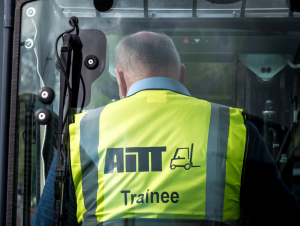Forklift feature articles
The largest forklift operator training website in the world
![]()
![]()
ABA creditable recognition of standards

This article by Adam Smith, boss of AITT, explains in detail how the ABA accreditation of training for forklift operators works.
We understand that there can sometimes be misunderstandings about the ABA and its main purpose, so we have set out some simple facts and myth busters about the ABA.
Background
In 1988 the first code of practice (now L117) produced guidance for operator training of rider operated lift trucks. This was produced with the help of the recognised lift truck accrediting bodies. In 2010 the HSE revised the L117. They decided that it was no longer necessary to continue to manage the accrediting bodies schemes on a day to day basis.
They wished to “hand the scheme back” to the industry themselves to manage, and for the HSE to take an advisory role. Therefore, at the request of the HSE, a new association was formed as a result of this effort - “Accrediting Bodies Association – Workplace Transport” (ABA)
Much time and effort were spent by the accrediting bodies, creating a new way of working together for the benefit of the workplace transport industry, aimed to improve standards, coupled with much clearer transparency for those utilising the accrediting bodies system.
AITT are founding members of the ABA, and are proud to work collaboratively with RTITB, ITSSAR and NPORS
Fact Checking and Myth Busting!
- Does the HSE have a working relationship with the ABA?
A common misconception is that the HSE are no longer involved with the ABA. This is categorically not the case. The ABA work very closely with the HSE. Their representatives are in attendance at ABA meetings, and standard development sessions. In addition to this, the HSE and other linked agencies frequently request the input of ABA members for technical guidance for ongoing cases when clarification of operator training is under question.
- Who runs the ABA?
All members of the ABA equally share responsibility. There is typically 4 arranged meetings a year including an annual development summit. There is an elected chairman that is rotated every 2 years. Nobody is paid, and there are no employees. All running costs are shared across each member.
- What is the main purpose of the ABA?
The 4 main purposes of the ABA are to:
- Formulate workplace transport grouping lists; providing clarity on truck categorisation.
- Standardise lift truck basic operator testing; resulting in a minimum standard of a national test, supported by all main accrediting bodies.
- To improve safety by continuously reviewing testing standards
- To providing training guidance to the HSE
- Why doesn’t the ABA standardise course lengths?
Each accrediting body that sits within the ABA, have their own methods of providing basic training. Therefore, it is down to each accrediting body to determine their course lengths for their scheme. Any collaboration of course lengths could be perceived as a cartel, and against competition law. anti-competitive.
- Why only 4 members?
The ABA is formed of the 4 main recognised accrediting bodies for workplace transport in warehousing and logistics. AITT, ITSSAR, NPORS and RTITB.
The ABA is the “KITE mark” of workplace transport accreditation. It is widely recognised as the standard for our industry. Alternative accreditation schemes (that currently sit outside of the ABA) are welcome to apply for membership but must meet the code of practice that is currently set out, to ensure credibility, and compliance with the common goal that the HSE request.
- Who regulates members of the ABA?
To ensure members are complying with the code of practice, the ABA have appointed auditors. (currently FTA) This is to ensure that each member is adequately checked to have the infrastructure, quality management systems etc, in place.
- Is there a “DVLA style” national database which holds all operator training records?
It is a requirement of the ABA, that each member is to hold a database that verifies a minimum requirement of operator training records. Each member runs their own unique scheme, making the process currently impossible to draw together all records.
The ABA is not responsible for holding any candidate data. Therefore, cannot confirm training, or reproduce any form of certification.
- Do the ABA “Police” the workplace transport training industry
No, the ABA’s nominated auditors are there to make sure the accrediting bodies are providing their due diligence, but complaints or issues should be brought to the relevant accrediting body.
- Is forklift training received via an ABA accrediting body to a higher standard?
Training can be delivered to the same standards via a non-accredited course, however only by providing training under an ABA accrediting body, will you be certain that the test criteria has been provided to ABA standards and has been verified against these.
Employers should look to see that training has been externally verified to ensure it meets the requirements of the L117, and that the accrediting body that has adequately verified the course, is working to the standards set by the HSE who helped develop the scheme.
For more information visit www.abawt.co.uk